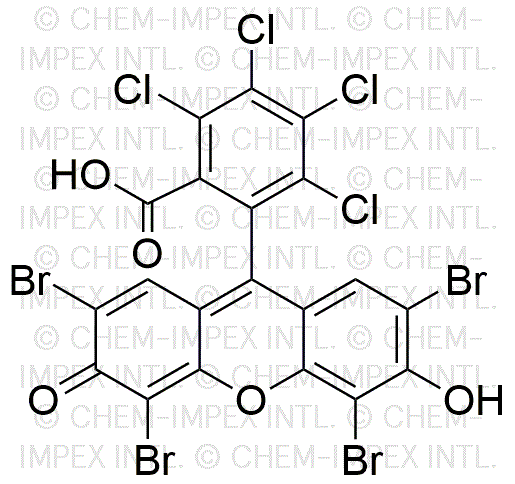2',4',5',7'-Tetrabromo-3,4,5,6-tetrachlorofluorescein is widely utilized in research focused on:
- Fluorescent Tracers: This compound is commonly used as a fluorescent tracer in biological and environmental studies, allowing researchers to visualize and track cellular processes or pollutant dispersion in water bodies.
- Analytical Chemistry: It serves as a reagent in analytical chemistry for detecting and quantifying various substances, enhancing the sensitivity of assays and improving accuracy in measurements.
- Histology and Microscopy: In histological applications, it is employed as a staining agent, providing clear contrast in microscopy, which is essential for studying tissue samples and cellular structures.
- Environmental Monitoring: The compound is used in environmental monitoring to assess the presence of heavy metals and other contaminants in soil and water, aiding in pollution control and remediation efforts.
- Research in Photonics: It plays a role in photonics research, particularly in developing new materials for optical devices, due to its unique fluorescent properties that can be tailored for specific applications.
General Information
Properties
Safety and Regulations
Applications
2',4',5',7'-Tetrabromo-3,4,5,6-tetrachlorofluorescein is widely utilized in research focused on:
- Fluorescent Tracers: This compound is commonly used as a fluorescent tracer in biological and environmental studies, allowing researchers to visualize and track cellular processes or pollutant dispersion in water bodies.
- Analytical Chemistry: It serves as a reagent in analytical chemistry for detecting and quantifying various substances, enhancing the sensitivity of assays and improving accuracy in measurements.
- Histology and Microscopy: In histological applications, it is employed as a staining agent, providing clear contrast in microscopy, which is essential for studying tissue samples and cellular structures.
- Environmental Monitoring: The compound is used in environmental monitoring to assess the presence of heavy metals and other contaminants in soil and water, aiding in pollution control and remediation efforts.
- Research in Photonics: It plays a role in photonics research, particularly in developing new materials for optical devices, due to its unique fluorescent properties that can be tailored for specific applications.
Documents
Safety Data Sheets (SDS)
The SDS provides comprehensive safety information on handling, storage, and disposal of the product.
Product Specification (PS)
The PS provides a comprehensive breakdown of the product’s properties, including chemical composition, physical state, purity, and storage requirements. It also details acceptable quality ranges and the product's intended applications.
Certificates of Analysis (COA)
Search for Certificates of Analysis (COA) by entering the products Lot Number. Lot and Batch Numbers can be found on a product’s label following the words ‘Lot’ or ‘Batch’.
Número de catálogo
Número de lote/lote
Certificates Of Origin (COO)
This COO confirms the country where the product was manufactured, and also details the materials and components used in it and whether it is derived from natural, synthetic, or other specific sources. This certificate may be required for customs, trade, and regulatory compliance.
Número de catálogo
Número de lote/lote
Safety Data Sheets (SDS)
The SDS provides comprehensive safety information on handling, storage, and disposal of the product.
DownloadProduct Specification (PS)
The PS provides a comprehensive breakdown of the product’s properties, including chemical composition, physical state, purity, and storage requirements. It also details acceptable quality ranges and the product's intended applications.
DownloadCertificates of Analysis (COA)
Search for Certificates of Analysis (COA) by entering the products Lot Number. Lot and Batch Numbers can be found on a product’s label following the words ‘Lot’ or ‘Batch’.
Número de catálogo
Número de lote/lote
Certificates Of Origin (COO)
This COO confirms the country where the product was manufactured, and also details the materials and components used in it and whether it is derived from natural, synthetic, or other specific sources. This certificate may be required for customs, trade, and regulatory compliance.


